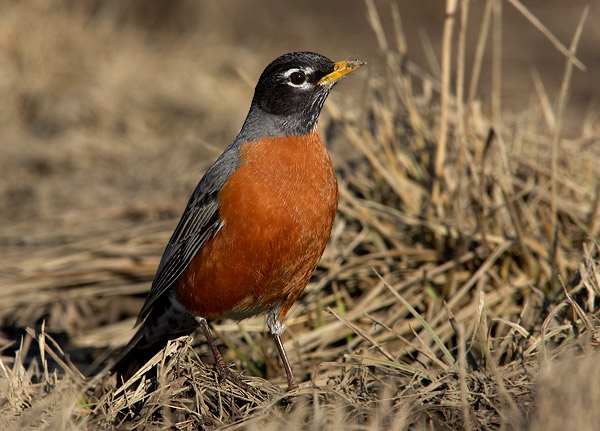American Robin - Turdus migratorius

The American Robin is a familiar sight pulling up worms on suburban lawns. Although it's at home breeding in deep, mature forests, the robin is the most widespread thrush in North American thanks to a tolerance for human-modified habitats.
Cool Facts
- Hundreds of thousands of American Robins can gather in a single winter roost. In summer, females sleep on the nests and males congregate in roosts. As young robins become independent, they join the males in the roost. Female adults go to the roosts only after they have finished nesting.
- The American Robin eats both fruit and invertebrates. Earthworms are important during the breeding season, but fruit is the main diet during winter. Robins eat different types of food depending on the time of day; they eat earthworms early in the day and more fruit later in the day. Because the robin forages largely on lawns, it is vulnerable to pesticide poisoning and can be an important indicator of chemical pollution.
- An American Robin can produce three successful broods in one year. On average, though, only 40 percent of nests successfully produce young. Only 25 percent of those fledged young survive to November. From that point on, about half of the robins alive in any year will make it to the next. Despite the fact that a lucky robin can live to be 14 years old, the entire population turns over on average every six years.
- Although the appearance of a robin is considered a harbinger of spring, the American Robin actually spends the winter in much of its breeding range. However, because they spend less time in yards and congregate in large flocks during winter, you're much less likely to see them. The number of robins present in the northern parts of the range varies each year with the local conditions. For a discussion of how snow cover affects wintering robins, based on Great Backyard Bird Count data, here.
Description
- Size: 20-28 cm (8-11 in)
- Wingspan: 31-40 cm (12-16 in)
- Weight: 77 g (2.72 ounces)
- large thrush.
- Back and wings gray.
- Underparts red.
- Dark head with white eye crescents.
- Throat white with black streaks.
- Lower belly and under tail white.
- Gray tail moderately long with white spots at corners of outer tail feathers.
- Bill yellow.
- Occasionally show pale eyestripes on pale individuals.
Sex Differences
Sexes look similar; female paler, especially on head.
Immature
Juvenile looks somewhat similar to adult, but has black spotting on underparts, pale spotting on upperparts, white throat, and paler head.
Sound
Song a musical whistled phrase, "cheerily, cheer up, cheer up, cheerily, cheer up." Call note a sharp "chup." Also a very high-pitched thin whistling note
Listen to songs of this species: American Robin #1 American Robin #2
Range
Range Map
Summer Range
Breeds throughout most of North America, from Alaska and northern Canada southward to northern Florida and Mexico.
Winter Range
Winters mostly south of Canada to Florida and Gulf Coast, to central Mexico. Winters along Pacific Coast to southern Alaska.
Habitat
- Found in forests, woodlands, and gardens, especially where short-grass areas are interspersed with shrubs and trees.
- Common in urban and suburban areas.
Food
Invertebrates, especially earthworms, and fruit.
Behavior
Foraging
Forages primarily on the ground for soft-bodied invertebrates. Finds worms by sight, then pounces on them and pulls them up.
Reproduction
 American Robin Nest
American Robin Nest

American Robin Eggs
Nest Type
An open cup of grass and twigs held together with a thick layer of mud. Lined with fine dry grass. Nest is usually relatively low in a tree on a firm branch with dense foliage, but can be placed from ground to treetop.
Egg Description
Color: Robin's egg blue.
Size: 28.4 “30.3 mm x 20.5 “21.4mm.
(1.12-1.19 in x 0.81-0.84 in)
Incubation: 12-14 days.
Clutch Size
Usually 3-4 eggs. Range: 2-5.
Condition at Hatching
Helpless with some sparse down.
Chicks fledge in 13 days.
Conservation Status
Populations appear stable or increasing throughout its range. Because the robin forages largely on lawns, it is vulnerable to pesticide poisoning and can be an important indicator of chemical pollution. You can help scientists learn more about this species by participating in the Celebrate Urban Birds! project.
Other Names
Merle d'Amérique (French)
Mirlo primavera (Spanish)
Credits to Cornell College of Ornithology